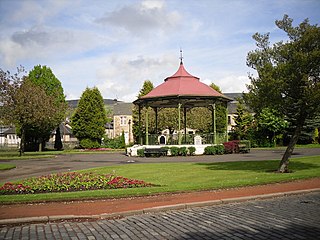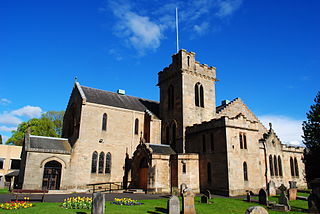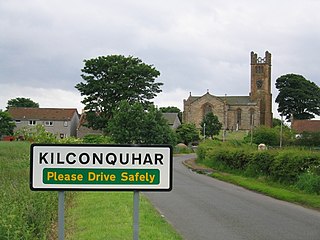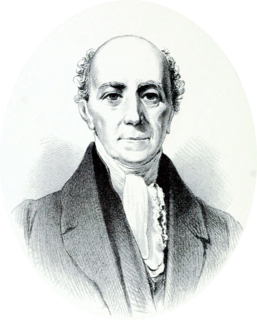Related Research Articles

Stirlingshire or the County of Stirling, Scottish Gaelic: Siorrachd Sruighlea) is a historic county and registration county of Scotland. Its county town is Stirling.

Kilsyth is a town and civil parish in North Lanarkshire, roughly halfway between Glasgow and Stirling in Scotland. The estimated population is 9,860. The town is famous for the Battle of Kilsyth and the religious revivals of the 18th, 19th, and 20th centuries. The town now has links with Cumbernauld at one time being part of Cumbernauld and Kilsyth District Council. The towns also have the same members of parliament at Holyrood and Westminster.

Fintry is a small riverside village in Stirlingshire, central Scotland.

Stair is a village in Ayrshire, Scotland. It lies at the bottom of a glen beside the River Ayr at the north-west border of the 5,376 acre (22 km2) Parish of Stair where the River Ayr is joined by the Glenstang Burn.

The Lennox is a region of Scotland centred on The Vale of Leven, including its great loch: Loch Lomond.

Mauchline is a town and civil parish in East Ayrshire, Scotland. In the 2001 census Mauchline had a recorded population of 4,105. It is home to the National Burns Memorial.

New Kilpatrick, is an ecclesiastical Parish and former Civil Parish in Dunbartonshire. It was formed in 1649 from the eastern half of the parish of Kilpatrick, the western half forming Old Kilpatrick. New Kilpatrick is also a disused name for the town of Bearsden.

Lennoxtown is a town in East Dunbartonshire council area and the historic county of Stirlingshire, Scotland at the foot of the Campsie Fells, which are just to the north. The town had a population of 4,094 at the 2011 UK Census.

Strathblane is a village and parish in the registration county of Stirlingshire, situated in the southwestern part of the Stirling council area, in central Scotland. It lies at the foothills of the Campsie Fells and the Kilpatrick Hills on the Blane Water, 12 miles (19 km) north of Glasgow, 14 miles (23 km) east-southeast of Dumbarton, and 20 miles (32 km) southwest of Stirling. Strathblane is a dormitory village for Greater Glasgow, and has a total resident population of 1,811.

The Carron is a river in central Scotland, rising in the Campsie Fells and flowing along Strathcarron into the Firth of Forth. It has given its name to several locations in Stirlingshire, as well as a type of cannon, a line of bathtubs, two warships, and an island in the Southern Hemisphere.

Kilconquhar is a village and parish in Fife in Scotland. It includes the small hamlet of Barnyards. It is bounded by the parishes of Elie, Ceres, Cameron, St Monans, Carnbee, Newburn and Largo. It is approximately 9 miles from north to south. Much of the land is agricultural or wooded. The village itself is situated inland, north of Kilconquhar Loch. Also in the civil parish are Colinsburgh and Largoward, the latter since 1860 being a separate ecclesiastical parish.

Slamannan is a village in the south of the Falkirk council area in Central Scotland. It is 4.6 miles (7.4 km) south-west of Falkirk, 6.0 miles (9.7 km) east of Cumbernauld and 7.1 miles (11.4 km) north-east of Airdrie.

California is a former pit village in the Falkirk council area of Scotland. It lies between Shieldhill and Avonbridge on the uplands which form the southern edge of the council area.

Dunduff Castle is a restored stair-tower in South Ayrshire, Scotland, built on the hillside of Brown Carrick Hills above the Drumbane Burn, and overlooking the sea above the village of Dunure.
Milton of Campsie is a village formerly in the county of Stirlingshire, but now in East Dunbartonshire, Scotland roughly 10 miles (16 km) north of Glasgow. Nestling at the foot of the Campsie Fells, it is neighboured by Kirkintilloch and Lennoxtown.
John de Crannach was a 15th-century Scottish scholar, diplomat and prelate. Originating in the north-east of Lowland Scotland, he probably came from a family associated with the burgh of Aberdeen. Like many of his relatives, he flourished in the 15th-century Scottish church. After just over a decade at the University of Paris, Crannach became a servant of the then Dauphin Charles (VII).
James Livingstone, 1st Viscount Kilsyth, was a devoted Scottish Royalist who was raised to the peerage of Scotland as Viscount Kilsyth and Lord Campsie in 1661.

The remains of the old castle of Montfode or Monfode lie to the north-west of the town of Ardrossan and 1.5 miles (2.4 km) south-west of West Kilbride in North Ayrshire, Scotland, above the Montfode Braes, in the old Barony of Kilbride. The remains of the 16th century tower are protected as a scheduled monument. The castle ruins are clearly visible from the A78 Ardrossan bypass.

Patrick MacFarlan was a Scottish minister who served as Moderator of the General Assembly of the Church of Scotland in 1834 and as Moderator of the General Assembly of the Free Church of Scotland in 1845.

Henry Hall was a Covenanter and Church of Scotland elder. He had firm Presbyterian convictions. He tried but was prevented from joining the Pentland Rising. He fought as an officer at Drumclog and at Bothwell Bridge. He was part of a group, along with Richard Cameron and Donald Cargill, who were openly opposed to the government's religious policies. Hall was intercepted at South Queensferry where Robert Middleton, the governor of Blackness Castle, tried to arrest him along with Donald Cargill. Hall managed to hold off the governor but received a mortal headwound from the butt of a gun from a taxman after Cargill had escaped. An unsigned and probably unfinished work known as The Queensferry Paper was found on Hall which caused considerable disquiet when it was read by government supporters.
References
- ↑ Ordnance Survey Maps
- ↑ "Finglen Burn from The Gazetteer for Scotland". www.scottish-places.info. Retrieved 27 December 2021.
- ↑ "Club Waters – Campsie Angling Association" . Retrieved 27 December 2021.
- ↑ Nimmo, William (1817). History of Stirlingshire. p. 754.
- ↑ Cameron, John. The Parish of Campsie: A Series of Biographical, Ecclesiastical, Historical, Genealogical, and Industrial Sketches and Incidents. p. 77.
- ↑ Cameron, John. The Parish of Campsie: A Series of Biographical, Ecclesiastical, Historical, Genealogical, and Industrial Sketches and Incidents. p. 48.
- ↑ Cameron, John. The Parish of Campsie: A Series of Biographical, Ecclesiastical, Historical, Genealogical, and Industrial Sketches and Incidents. pp. 105–106.
- ↑ Cameron, John. The Parish of Campsie: A Series of Biographical, Ecclesiastical, Historical, Genealogical, and Industrial Sketches and Incidents. p. 119.
- ↑ Cameron, John. The Parish of Campsie: A Series of Biographical, Ecclesiastical, Historical, Genealogical, and Industrial Sketches and Incidents. pp. 124–125.
- ↑ British Rainfall. 1885. p. 28.
Coordinates: 55°58′47″N4°13′42″W / 55.979765°N 4.228416°W